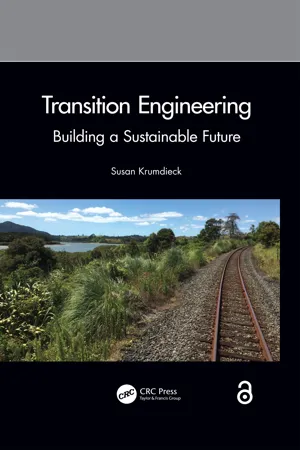I entered engineering at university in 1981. I was passionate about sustainability and especially about sustainable energy. The Four Corners Power Plant had been built in the previous decade and had caused serious pollution and acidification of mountain lakes and streams in the remote and unpopulated wilderness of its surrounding region. I wanted to figure out how to fix polluting cars and power plants and how to change to renewable energy. Hydroelectricity was already a main source of power at that time, but the cost in loss of beautiful landscapes had been high. Wind turbines, solar hot water and Photovoltaic (PV) panels, and geothermal power plants are much more reliable, larger scale and lower cost than they were in 1981. But I would like young readers to know that 30 years ago we were told that if we worked on these alternatives, including electric cars, fuel cells and biofuels, to make them competitive with fossil fuels, then we would see the transition to sustainable energy. There is something fundamentally wrong with that story. The reason that the field of Transition Engineering now exists is because reducing fossil fuel production and use is a major engineering challenge; it will not be the natural result of achieving viability of renewable alternatives. It is fine and good that renewable energy technologies and energy efficiency have progressed substantially since the 1980s, but it is not sufficient.
1.2.1 A SHORT WORLD HISTORY OF DEVELOPMENT
Unsustainability is the fundamental problem. Civilizations are either sustainable or they are not, and their worldview plays a part in whether they change unsustainable activities (Diamond 2005). In the ancient world, the worldview reflected the cyclical pattern of life. Starting in the classical Greco-Roman period, a more linear view of time emerged. By the Middle Ages, it was normal to think that society would cumulatively progress from lesser or more primitive forms to more developed and moral forms, with the ultimate spiritual perfection being found in the next world.
Through the eighteenth and nineteenth centuries, science became inextricably linked with the concept of an overall plan for the march of humankind that involved mastery over nature and developing the wilderness for the betterment of civilization. The industrial revolution provided the proof of the doctrine of progress and the rightness of humanity’s domination of nature. By the beginning of the current century, Americans and Europeans had a widespread belief in progress and that things only have value if they are produced by industry and given license by the magic of the market (Du Pisani 2006).
It is important for you to recognize your belief in the unstoppable progress of humankind through the optimism of science and technology, and the virtue of the freedom of the individual to capitalize and profit from this march of inevitable development. Look at a graph of any indicator of industrial progress, such as the production of oil or iron ore, kilometres travelled or cars manufactured, and you will see a sharp exponential trend upwards starting after World War II. The population was growing fast. The growth in pollution and environmental impacts from resource extraction and manufacturing were so rapid that the degradation of land, air and water caused widespread alarm. This was not the first time that human activity had caused environmental degradation that threatened prosperity. In the fifth century BC, the philosopher Plato warned about the loss of soil fertility and desertification of the forests due to excessive logging and farming.
The first use of the word sustainability was in 1713 in relation to the problem of deforestation in Germany. The term nachhaltende Nutzung referred to the sustainable use of the forests by balancing the harvest of old trees and regeneration of young trees. All across Europe the ancient forests were being rapidly depleted in the eighteenth century to build ships and growing cities and to fuel iron smelters and industry. The idea emerged in Germany to establish ewiger Wald, eternal forests that required aggressive afforestation and regeneration.
Great Britain found a different solution to the problem of forest depletion: the Crown’s colonies in America, Australia, South America and New Zealand sustained the growth in shipbuilding and construction. After 1790 Great Britain’s coal production increased rapidly, providing high-temperature heat energy to make steel and run steam engines. By the 1860s, the easy-to-access coal deposits were becoming depleted, and alarms were raised calling for more efficient and less wasteful use of coal (Du Pisani 2006). Luckily in this same timeframe, the science of thermodynamics and the practice of mechanical engineering were beginning to deliver significant improvements in efficiency. The progress of science and technology, along with the trend for globalization, sustained development after Europe’s most accessible resources were depleted. The progress narrative of developed countries is steeped in a long history of new technologies and new resources being found to overcome problems.
The word economy meant management of household resources or increased value until the twentieth century, when it has become a thing: the economy. Politics focused on growing the economy. The global economic growth rate was maintained at an unprecedented 5.6% for more than 20 years, from 1948 to 1971. Economists have been aware of the problems of unsustainability. The theory is that as a resource becomes scarce, new technologies would be introduced to replace the scarce resource. Putting a price on environmental damage, called externalities, can stimulate new mitigation technologies, resulting in more economic growth. The current worldview holds that even as we face the social and environmental challenges of progress, this stimulates even more growth. This is one reason why the measure of economic growth, the gross domestic product (GDP), includes all spending whether it was on good things like milk, unhealthy things like soft drinks or remedies like new medical treatments for diabetes and tooth decay.
In recent decades, the increasing wealth gap between the developed and developing post-colonial countries gave rise to the idea that these countries must modernize. Modernization means opening their markets and providing incentives for international corporations to export their primary products and privatize their public services. By the 1980s, it was clear that the international wealth created by modernization was actually impoverishing the developing countries. The environmental movement in the 1970s saw the creation of non-governmental organizations such as Greenpeace and Friends of the Earth, whose activities were aimed at essentially stopping the most destructive development projects. After the energy and environmental crises of the 1960s and 1970s, a wave of books and films were released that extrapolated the growth rates in consumption and environmental damage and predicted collapse of population and industrial civilization (Meadows et al. 1972).
Since the 1970s, environmentalists and economists converged on the idea of sustainable development as the way to continue the project of civilization by steering technology into green products and green energy. Essentially, economists will not change their view, because it seems to be working fine, and environmentalists will not change their view, because the threats to the environment continue to get worse. Both economists and environmentalists also agree that wasteful consumer behaviour is one of the main problems, even though consumers do not have any control over the design of products, manufacturing processes, vehicles or buildings. If there is to be change, it appears it will be left to technologists to sort out what to change and how to accomplish...

